- Home
- Behavior Problems
- Cats Scratching Furniture
Disclosure: this site is reader-supported. When you buy through links on our site, we may earn a small commission, at no extra cost to you.
How to Stop Cats From Scratching Furniture?
Curbing This Inappropriate Behavior
How to stop cats scratching furniture? The problem of inappropriate cat scratching is so frustrating!
Pet parents facing this problem sometimes consider declawing, some try scratchers and posts, and others look for behavior training advice on how to stop cats scratching furniture.
It is possible to solve cat clawing problems, for good!
Table of Contents:
- 4 Reasons Cats Scratch
- Getting Kitties to Scratch Appropriate Surfaces
- How to Stop Cats Scratching Furniture
- Addressing Sharp Claws
Why Do Cats Scratch Furniture and Carpets?
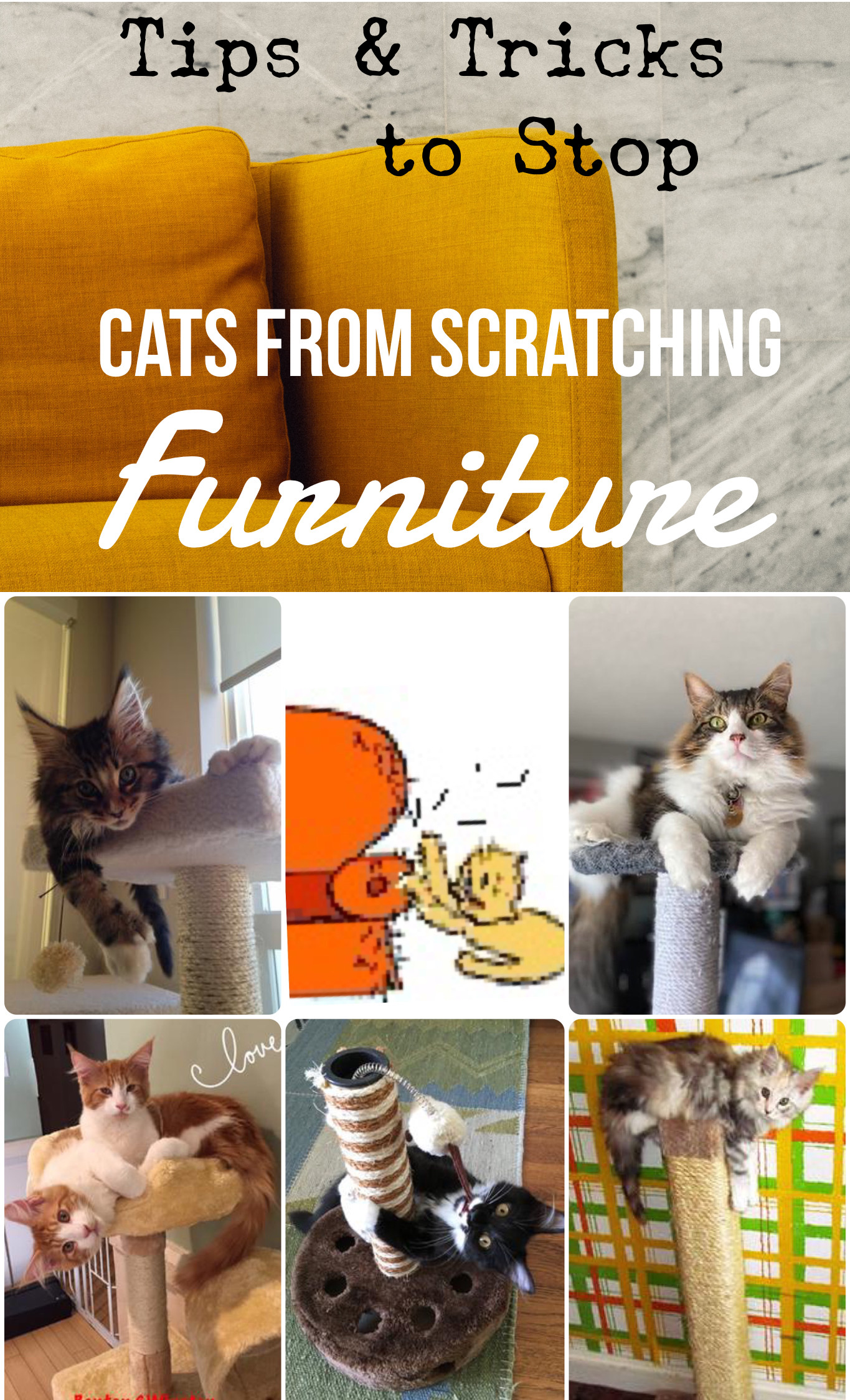
they are not trying to be naughty! Animals don't have human emotions, such as anger or vindictiveness.
You may sometimes hear pet owners say "Fluffy was mad at me so he did such-and-such." Know that this is rubbish!
Cats scratching furniture is a behavior problem stemming from instinct, pure and simple. A little behavior training will teach him what is allowed in the house, and what is not.
If he continues to scratch when you are not looking, it means he physically needs to scratch!
For example, we very rarely find our Coonies on our kitchen counter. They know it's not allowed.
When we have found them up there, we quickly noticed their water dish could use a fresh refill. Every time. They were just thirsty, not naughty!
4 Reasons Cats Scratch:
Instinct:
Felines need to sharpen their claws. Why? In the wild, they need those sharp claws for hunting, as we know.
And although they get all their nutrition from the food dish nowadays, they still have those animal instincts.
Just as we humans have tendencies that go way back to our ancestors and survival, such as the need for socialization and belonging, today's kitties still have this need to sharpen their claws. It's something we have to accept, and work with!
Physical Health Benefits:
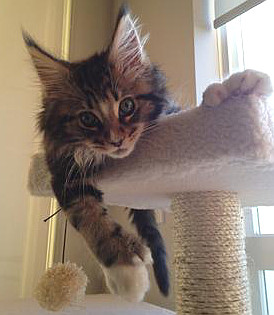 Hunter the kitten lounging on his furniture
Hunter the kitten lounging on his furnitureThere are physical reasons for cats to scratch, too. When you see a cat clawing at furniture (or woodwork, or his post) his whole body is benefiting.
He is stretching his muscles and body. It's good for his overall health.
That regular stretching keeps him in top condition, which will pay off in his senior years. He may have better joint health as a result.
The Importance of a Good Stretch:
A healthy feline will "hook" his claws into a scratching post or other surface, and then he can stretch the muscles in his legs, back, shoulders, and paws.
He pulls back against his own claw-hold, and this is the only way he can tone these muscles.
Mental Health Benefits:
Interestingly, there are scent glands between a cat’s claws, called interdigital glands. When a cat scratches, he releases and leaves behind a pheromone on the object or location called feline interdigital pheromone.
There are a number of reasons felines do this beyond the common explanation of 'marking their territory.'
In multi-cat households, this is part of it. But it's not the same as when we think of a male kitty spraying to mark his territory. It can be likened more to a feline leaving their mark with a pheromone message of "I live here too." Or, "this is home."
It brings them comfort, much like when they rub their face on a doorway or person, which is also using scent glands to leave a message of this place is safe, this person is a friend.
Stress Relief:
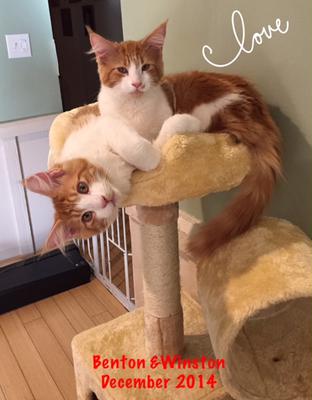 Benton and Winston relaxing
Benton and Winston relaxingSince they use scratching behavior and pheromones to mark areas as 'safe,' it makes sense that a stressed out kitty may be more prone to engaging in unwanted clawing of furniture around the home.
He finds these scent markings reassuring.
As you can see, this is a natural behavior!

Appropriate Scratching Behavior:
How to stop cats scratching furniture using cat behavior training:
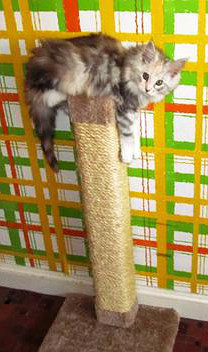 Bella the Maine Coon kitten on her very own post
Bella the Maine Coon kitten on her very own postSo how do you honor a cat’s need to scratch while also preserving your home, possessions, windowsills and new sofa? First, decide where you would like your feline friend to scratch.
It's a good idea to provide him with a well-made scratching post or other place to engage in this natural cat behavior. A cat scratcher is a must have for indoor kitties!
Remember that cats are individuals, just like people. Keep in mind their preferences when choosing a surface for them to use.
One kitty may prefer a vertical scratcher while another may gravitate to horizontal surfaces for a good scratch and stretch.
Vertical scratching posts may be a hit with cats who have a habit of reaching up and stretching (and clawing) on doorways, tree trunks or other vertical surfaces.
Luckily, we have many options on the market nowadays! Vertical posts come in a variety of textures such as carpet or sisal rope, which tends to hold up well.
Or perhaps kitty would prefer a horizontal scratcher. There are infinity shaped scratchers (which are great for lounging on as well) and flat scratchers to choose from.
Also, it has been shown that cats show a preference toward cardboard surfaces. It's no wonder these are becoming popular too!
Here are 3 of the most popular scratchers on this site:
 SmartCat Ultimate Scratching Post |
 PetFusion Ultimate Cat Scratcher Lounge |
 FUKUMARU Cat Scratcher Mat FUKUMARU Cat Scratcher Mat |
Getting pets to use their new scratching post:
If your kitty is cooperative and will let you, you can help him by revealing his claws and gently showing him how to scratch on the new post. He will make the connection.
It may take time, persistence, and as with any type of pet behavior training, consistency is key!
Some cat scratchers come with catnip to help attract them to it. Feliway, long-time maker of pheromone sprays to aid in cat training and stress relief for pets now has a product called Feliscratch - made just to help attract kitties to their new post!
It's a blue liquid that you squeeze in lines mimicking claw marks on the scratcher.
It gets applied according to a schedule and leaves a synthetic copy of the pheromone message that cats naturally leave when using their claws on a surface, and is effective on vertical or horizontal scratchers.
Make sure it's accessible to him, and in a good location. Put it where he likes to spend time and preferably where you can see it, too.
Curbing a Destructive Clawing Problem:
Whenever you catch your cat clawing furniture or inappropriate objects, make sure to stop whatever you're doing and distract him immediately.
You can surprise him by clapping, or saying "No!" or "Psst!" Then get up and physically take him to the scratcher.
Try not to scare him - remember, he was just in the middle of creating a safe space, or looking to self-comfort. Being too aggressive with scolding or yelling could just exacerbate the problem by making him fearful or insecure.
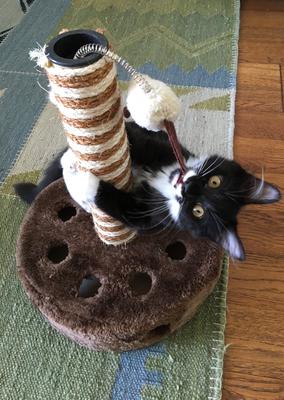 Zorro the kitten on his post
Zorro the kitten on his postWhen You Can't Be There to Supervise - Tricks and Products
If your feline friend has the run of the house when no one is home, consider covering his favorite "cat scratching furniture" with a sheet or blanket. Or try some double-sided adhesive tape on his favorite spot.
Many owners have had success keeping cats off counters using aluminum foil. This may work well as a deterrent in other areas as well.
Also, you could try a cat deterrent spray designed to deter felines from an area.
Natures's Miracle, maker of the popular cleaning spray for pet odors, offers Pet Block Spray. It's safe for use around pets and in home, it has an odor that deters pets from the area.
Cats Scratching Furniture: Addressing The Claws
Using a nail trimmer:
For some people, the cat's claws are seen as the problem. In this case there are things you can do.
When our kittens were young and particularly hard on our floors, we trimmed their claws regularly. It's very easy.
Simply hold your cat’s paw, and press the claw out of its "pocket." Then, using guillotine style nail clippers just snip off the sharp top tips.
Cat Claw Covers
These are basically little rubber sleeves that you glue on to cat’s nails. Most cats don't even notice them, and claw covers provide a humane option for their owners. Visit our page on Soft Paws to learn more about them and see our review.
Of course, there are people who opt for declawing. Declawing is seen more among pet owners who view clawing as a destructive, aim-for-the-couch, inevitable behavior.
The practice of declawing cats has fallen out of favor in recent times. More and more people are aware of what it really entails.
Declawing is an extremely painful surgical procedure, wrought with possible complications and many behavioral and health consequences. It is considered mutilation, inhumane, and is now banned in many areas.
How To Stop Cats Scratching Furniture - In Summary:
Cats need to scratch. This normal behavior is the only way they can properly stretch their ligaments and muscles, and it promotes good joint health.
Scratching also relieves stress when a feline uses scent glands to leave pheromones behind that mark the area as home, or safe.
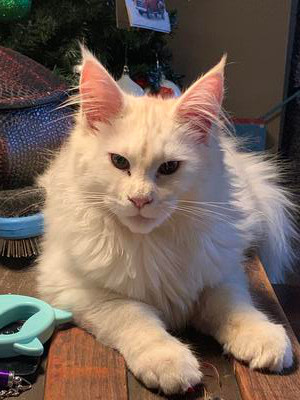 Ryker is very well-behaved
Ryker is very well-behavedUsing techniques and products such as sticky tape, a spray bottle and gentle distractions and redirections, it is possible to train cats to stop destructive clawing.
By using positive reinforcement like treats, catnip and even praise, they can be redirected to their own cat scratching post, tree, or mat.
If all else fails, clipping their claws or covering them with nail caps such as Soft Paws is always an option.
If you are dealing with cats scratching furniture, take heart! Consistent cat behavior training, and patience, should see the problem resolved.
Top of How To Stop Cats Scratching Furniture
« Back to Behavior Problems
Recent Articles
-
Today's Features
Apr 16, 25 09:54 PM
Today we have two classic Memory Lane pages to share!
Murphy & Candy Cane: Double the Maine Coon Charm - This adorable Maine Coon duo from our 2011 Photo Albums - Murphy and Candy Cane - brought doubl… -
Memory Lane Month Begins!
Apr 15, 25 10:22 PM
We're thrilled to start our "Memory Lane Month" event by visiting some cherished moments from our community! We're in the process of restoring meaningful community stories like this one, to preserve t… -
Will a Maine Coon Protect Its Owner From Danger or an Intruder?
Apr 09, 25 10:41 PM
Plenty of people are curious: Will a Maine Coon protect its owner if something happens? Let’s talk about what this means, and what kind of protector a Coonie is.



